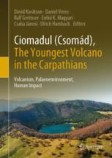Search
Search Results
-
“Unwanted Guests”: Evidence of Parasitic Infections in Archaeological Mortuary Contexts
Parasites have had a significant impact on the course of human history—parasites have caused the deaths of countless individuals, have resulted in...
-
Ground Disturbances in Different-Age Sediments of the Klinsko-Dmitrov Ridge
AbstractIn this paper we study paleocryogenic formations and lithogenic dislocations that arose both during and after the formation of deposits in...

-
Palaeoecology and conservation of endangered hidden species; example of the liverwort Riella (Riellaceae)
Palaeoecology is increasingly contributing to conservation biology and restoration ecology by extending the recent annual to decennial records of...

-
Vegetation History and Human Impact in the Ciomadul Area During the Holocene
Plant biodiversity is very sensitive to environmental changes, especially changes in climate. The study of vegetation history helps us understand the...
-
Late Pennsylvanian fishes from the Finis Shales of North-Central Texas (USA)
A diverse assemblage of fish microremains is reported from the Virgilian (Gzhelian), Upper Pennsylvanian Finis Shale outcrop at Lost Creek Lake near...

-
The “Diahot Tooth” is a Miocene rhinocerotid fossil brought by humans to New Caledonia
The “Diahot Tooth” is an isolated postcanine tooth of a large herbivorous mammal, discovered in the Diahot region of northern New Caledonia in 1875....

-
The floor: a voice of human lifeways—a geo-ethnographical study of historical and recent floors at Dolní Němčí Mill, Czech Republic
Is there a story that floor layers tell us about human history? A set of former floors were investigated using a combination of micromorphology,...

-
The Constructed Biodiversity, Forest Management and Use of Fire in Ancient Amazon: An Archaeological Testimony on the Last 14,000 Years of Indigenous History
Tropical rainforests have retained an image of being pristine environments scarcely occupied by humans over the millennia. Archaeological research...
-
Paleoecological Conditions of Yuka Mammoth’s Habitat and the Yano-Indigirka Lowland’s Vegetation Patterns during the Late Pleistocene
AbstractThe vegetation, widespread during the life of a young female mammoth “Yuka”, about 34 300 yr ago (GrA-53289) was reconstructed as a complex...

-
On the Revision of the Permian Ray-Finned Fishes of European Russia. Part 1
AbstractSome originals of Permian ray-finned fishes from European Russia from the collection of D.N. Esin, which was transferred to PIN RAS, are...

-
Middle Holocene hunting-gathering culture and environmental background of the steppe area of northern China
For a long time, the academic community has known very little about hunter-gatherers in the steppe area of northern China in the mid-Holocene. This...
-
Sensory Perspectives on Maize and Identity Formation in Colonial New England
A sensory perspective in archaeology provides insight into a range of past cultural practices, including foodways. An ongoing examination of the role...
-
Small things can make a big difference: a comparison of pollen and macrobotanical records of some food plants from medieval and post-medieval cesspits in the Netherlands and northern Belgium
This paper presents a review of records of pollen and botanical macroremains of a selection of food plants from late and post-medieval cesspits (12th...

-
Direct dating reveals the early history of opium poppy in western Europe
This paper aims to define the first chrono-cultural framework on the domestication and early diffusion of the opium poppy using small-sized botanical...

-
The use of Cornus sanguinea L. (dogwood) fruits in the Late Neolithic
Numerous fragments of Cornus sanguinea (dogwood) fruit stones were found in the cultural layer of the Late Neolithic pile dwelling site Strojanova...

-
Diet analysis reveals pre-historic meals among the Loma San Gabriel at La Cueva de Los Muertos Chiquitos, Rio Zape, Mexico (600–800 CE)
Coprolites have been a source of study for archeologists due to several reasons: they not only provide information on the life and nutritional habits...

-
The place of millet in food globalization during Late Prehistory as evidenced by new bioarchaeological data from the Caucasus
Two millets, Panicum miliaceum and Setaria italica , were domesticated in northern China, around 6000 BC. Although its oldest evidence is in Asia,...

-
Middle Devonian Acid Sulfate Paleosol: The First Finding in the Central Devonian Field (Voronezh High, Southern Russia)
AbstractThe Middle Devonian (Eifelian) paleosol (PS) recently discovered in the area of Voronezh Anteclise has been studied in detail. The PS is...

-
Plants from distant places: the 1st millennium ce archaeobotanical record from Iberia
The 1st millennium ce in the Iberian peninsula was characterized by a continuous exchange of people, goods, food, technology, etc. which led to the...

-
Deglaciation
The deglaciation of formerly glaciated areas can currently be observed in many regions of the world. The ice edge of Breiðamerkur Jökull in Iceland,...
